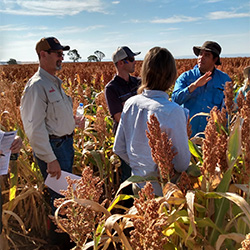
Swipe For More >
Brazilian Agriculture: A Hulk in the Global Market
Brazilian agriculture is a giant, and it’s growing at a surprising rate. Much like the Hulk, it has transformed from a modest figure into a formidable force, flexing its muscles on the global stage.
Recognizing the significance of this transformation, a delegation from the U.S. sorghum industry recently took a trade mission to Brazil to assess the opportunities and challenges this agricultural behemoth presents to the U.S. sorghum industry.
The Hulk’s Rise
In recent years, Brazil has muscled its way to the top ranks in global agriculture. It now stands as the world’s largest producer of soybeans, beef production and coffee, and it has climbed from the tenth to the fourth-largest producer of sorghum—in the last 10 years.
 “Brazil is a serious force that is changing international agriculture on an annual basis,” National Sorghum Producers CEO Tim Lust, a leading member of the U.S. delegation to Brazil, said.
“Brazil is a serious force that is changing international agriculture on an annual basis,” National Sorghum Producers CEO Tim Lust, a leading member of the U.S. delegation to Brazil, said.
Recognizing this shift, NSP and Sorghum Checkoff leadership aimed to gather insights into Brazil’s growing sorghum market and its broader agricultural landscape—insights essential for assessing the market dynamics and ensuring U.S. sorghum remains competitively positioned on the global stage.
According to the U.S. Department of Agriculture (USDA) Foreign Agricultural Service (FAS), Brazil went from planting 2.1 million acres of sorghum in 2020/2021 to almost 4 million acres in 2023/2024 with in-country projections for almost 6 million acres in the coming growing seasons. Right now, every bushel is used toward domestic livestock feed and fuel production. Brazilian farmers plant similar varieties to those available in the U.S., and the majority is grown as a double crop behind soybeans.
Research and Development: Harnessing the Hulk’s Power
One of the U.S. sorghum delegation’s primary goals was to explore research and development opportunities. The group met with key stakeholders, including Embrapa, CropLife Brazil and private seed companies. These discussions underscored the critical role of ongoing investment in sorghum research in both the U.S. and Brazil.
“The same companies that do research and development in the United States are also doing R&D in Brazil,” Sorghum Checkoff Chairman Kendall Hodgson, a sorghum farmer from Littler River, Kansas, who traveled with the team to Brazil, noted.
This overlap presents a unique opportunity for collaborative research, potentially leading to innovations that benefit both nations and help maintain the global competitiveness of U.S. sorghum.
Ethanol Production: Fueling the Giant
Brazil’s grain ethanol industry, now incorporating sorghum, is another significant area of interest. This development mirrors the U.S. ethanol industry’s growth in the early-2000s.
Brazil’s greenhouse gas reduction goals are to reduce emissions by 48% by 2025 and 53% by 2030, making ethanol production a critical component of the energy transition process. Providing clean energy from rural areas to urban centers is contributing to an 85% reduction in greenhouses compared to gasoline, according to UNEM, the Brazil Corn Ethanol Association.
Brazil has 22 operating grain ethanol plants currently, with 20 more planned or approved for construction, and sees opportunity to shift a significant portion of its grain sorghum production to domestic ethanol use going forward to help meet the country’s climate goals.
Infrastructure: The Hulk’s Weakness
Despite its formidable growth, Brazil’s agricultural infrastructure faces significant challenges. Roads, railways, ports and grain storage facilities are lacking and over-burdened—and they’re currently focused on meeting the increasing export and interstate demands for corn, cotton and soybeans. Unable to handle multiple growing commodities, these infrastructure challenges have necessitated that nearly all of the nation’s grain sorghum is used domestically.
“The United States is incredibly blessed with the infrastructure we have,” NSP Chairman Craig Meeker, a sorghum farmer from Wellington,
Kansas, who also took part in the trade mission, highlighted. “This is not something other countries, including Brazil, have at this point in time. Understanding these limitations can help U.S. producers leverage our logistical strengths.”
The U.S. sorghum delegation’s trip to Brazil underscored a critical reality: global agriculture is in constant flux, and Brazil is a significant player. The mission yielded valuable insights into the country’s growing sorghum industry. While Brazil’s growth presents challenges, it also offers opportunities for collaboration and mutual benefit.
###
This story originally appeared in the Summer 2024 Issue of Sorghum Grower magazine.


